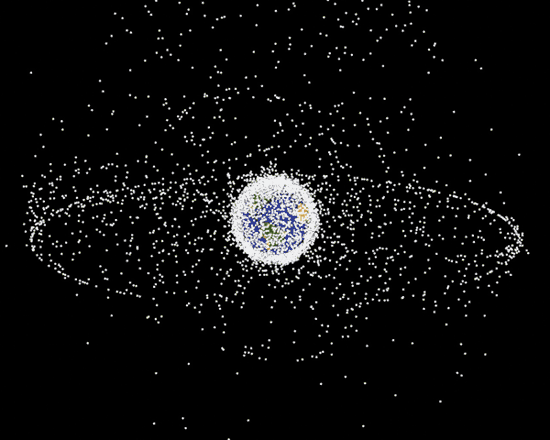The Impact of Flares
Solar flares produce high energy particles and radiation that are dangerous to living organisms. However, on the surface of the Earth, we are well protected from the effects of solar flares by the Earth's magnetic field and atmosphere. The most dangerous emissions from flares are energetic charged particles (primarily high-energy protons) and electromagnetic radiation (primarily x-rays).
The x-rays from flares are stopped by our atmosphere well above the Earth's surface. They do disturb the Earth's ionosphere, however, which in turn disturbs radio communications. Along with energetic ultraviolet radiation, they heat the Earth’s outer atmosphere, causing it to expand. This increases the drag on Earth-orbiting satellites, reducing their lifetime in orbit. Also, both intense radio emission from flares and changes in the atmosphere can degrade satellite communications, for example the precision of Global Positioning System (GPS) measurements can be degraded.

- The Sun-Earth connection
The most serious effects on human activity occur during major geomagnetic storms. It is now understood that the major geomagnetic storms are induced by coronal mass ejections (CMEs) which are frequently associated with flares. Like flares, CMEs are more frequent during the active phase of the Sun's approximately 11 year cycle. The exact relationship between flares and CMEs is still not well understood, as flares seem to trigger CMEs but sometimes CMEs are observed without any flares!
Coronal mass ejections are more likely to have a significant effect on our activities than flares because they carry more material into a larger volume of interplanetary space, increasing the likelihood that they will interact with the Earth. While a flare alone produces high-energy particles near the Sun, some of which escape into interplanetary space, a CME drives a shock wave which can continuously produce energetic particles as it propagates through interplanetary space. When a CME reaches the Earth, its impact disturbs the Earth's magnetosphere, setting off a geomagnetic storm. A CME typically takes 3 to 5 days to reach the Earth after it leaves the Sun therefore observing the associated solar flare or the ejection of CMEs from the Sun provides an early warning of geomagnetic storms.
One serious problem that can occur during a geomagnetic storm is damage to Earth-orbiting satellites, especially those in high, geosynchronous orbits. Communications satellites are generally in these high orbits. Either the satellite becomes highly charged during the storm and a component is damaged by the high current that discharges into the satellite, or a component is damaged by high-energy particles that penetrate the satellite.

- Each white dot in this image represents an object in orbit around the Earth. Note the ring which represents objects in geostationary orbit such as many communications satellites. Due to their large distance from Earth, they are much more susceptible to damage from solar particles. The swarm of objects around Earth includes objects such as the International Space Station and the Hubble Space Telescope. They are much better protected due to their proximity to the Earth's magnetic field.
Currently astronauts are not in immediate danger because they stay relatively near the Earth in low earth orbit. They do have to be concerned about cumulative radiation exposure during space walks. The energetic particles from a flare or CME would be dangerous to an astronaut on a mission to the Moon or Mars, however.
Another major problem that has occurred during geomagnetic storms has been the temporary loss of electrical power over a large region. The best known case of this occurred in 1989 in Quebec. High currents in the magnetosphere induce high currents in power lines, blowing out electric transformers and power stations. This is most likely to happen at high latitudes, where the induced currents are greatest, and in regions having long power lines and where the ground is poorly conducting.
The damage to satellites and power grids can be very expensive and disruptive. Geomagnetic storms are more disruptive now than in the past due to our greater dependence on systems that can be affected by electric currents (e.g. electronics) and energetic particles high in the Earth's magnetosphere (e.g. satellites).



